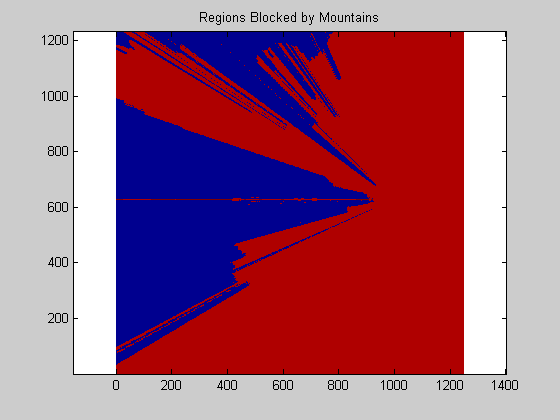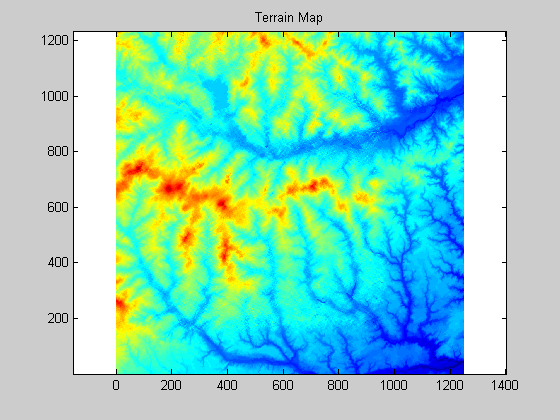
Technical Discussion
The proposed propagation model takes three important environment factors into account to predict received power strengths: terrain obstruction, transmitter- receiver angle, and distance.
Terrain Obstruction
Because a lack of line-of-sight can greatly reduce received power strength, the propagation model is designed to determine the presence of elevated mountainous terrain. Using the provided terrain map, all receiver points that lie on the backside of high terrain have 20dB deducted from their received power values. For the purpose of this propagation model, high terrain is defined to be any point with elevation higher than the height of the transmitting antenna tower. The MATLAB code is found here. Figure 1 shows the regions, in blue, where mountainous terrain would affect the transmitted signal. Figure 2 shows the corresponding terrain map. For this map, site B, the transmitter is located at (996, 628).

Figure 1

Figure 2
Directivity
Because the transmitter is not isotropic, directivity had to be taken into account when predicting received power strengths. Dr. Durgin suggested that a range of 120º was a reasonable estimate of the directivity for the transmitting antenna. To increase accuracy, a range of 110º was assumed. Points at angles between ±55º to the azimuth were estimated to have less signal attenuation than those outside of this range. At angles ±35º from the transmitter azimuth, 20dB gain was added. At angles between ± (35º-55º), 10dB gain was added. The code found here is the main function of the propagation model and shows how directivity was taken into account for map D.
Diffraction
Diffraction models were not included in the large scale path loss estimates in this propagation model. The primary reason for the omission of diffraction modeling was the difficulty in modeling such path loss. Though diffraction is the method by which waves are received in valleys surrounded by mountains, it is extremely difficult to distinguish the effects of diffraction from other factors in large-scale path loss such as scattering, reflection, and lack of line of sight. For this propagation model, it is assumed that path loss predicted by the terrain obstruction algorithm is the sum of the effects due to diffraction, scattering, and other large-scale path loss components.